The general layout of the motorcycle hasn’t changed much throughout history. There’s an engine or electric motor bolted to the frame, and via a chain, belt, or driveshaft, it drives the rear wheel.
The vast majority of motorcycles in the world haven’t deviated much from that formula. Even some of the earliest motorcycles from over a century ago had engines bolted to the frame between the wheels, and used some sort of power transmission device to drive the rear wheel.
There have been some variations on the theme. There are motorcycles that drive two rear wheels, like trikes and Ural sidecar rigs. There are also some really awesome all-wheel-drive motorcycles, like a Christini off-road bike. Some electric motorcycles use hub motors on their rear wheels, and one weird modern bike, the Verge, has a hubless rear wheel motor.

Some of the weirdest motorcycles of the past tried to reinvent the frame-mounted engine, driven rear wheel layout. One of them was the Killinger und Freund’s ‘Peace Dove’ motorcycle. In the 1930s, the German builder’s streamlined masterpiece did away with all convention by integrating the engine into the front wheel, creating a bizarre, yet intriguing front-wheel-drive motorcycle.
Front-wheel-drive motorcycles are extraordinarily rare. Some bicycle-to-moped conversion kits have driven their front wheels through friction drive (a motor with a drive wheel that runs on the bike’s existing front tire). There’s also the Solex, a French moped that used a friction drive engine to power the front wheel.
Some custom motorcycle builders have made impractical, but flashy front-wheel-drive one-off motorcycles, like the bizarre Quantum Leap by Eddie Meeks. I have to show this thing because it’s basically a motorcycle in reverse. The frame-mounted engine drives a 13-inch-wide front wheel, which doesn’t turn. Instead, turning is achieved through the skinny rear wheel, like a crazy forklift.
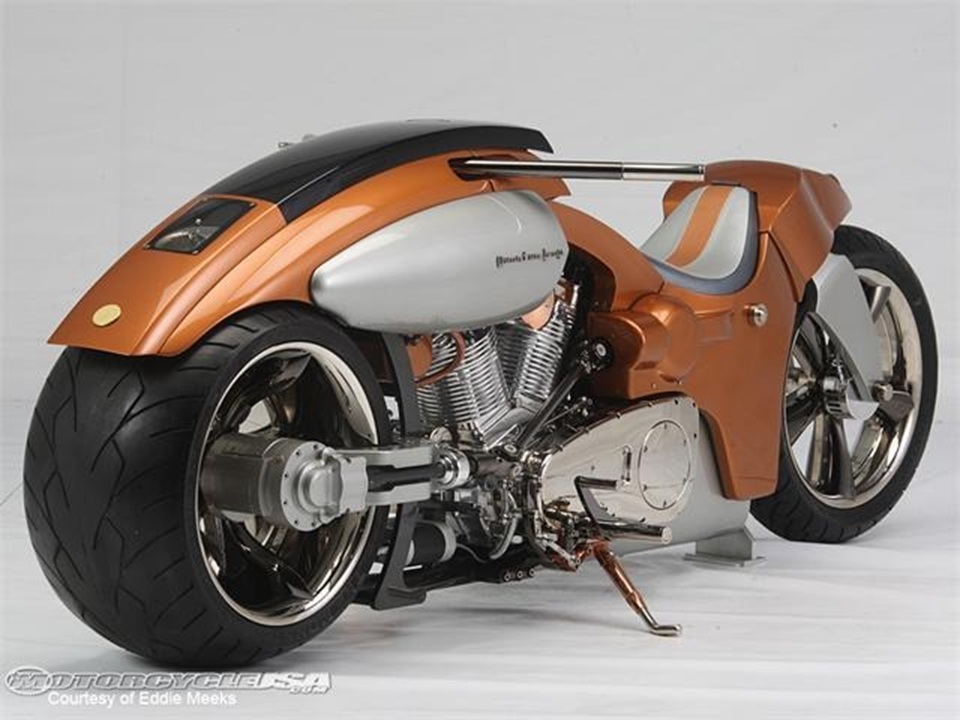
The book, The World Guide To Automobiles, details the story of Wilbur Gunn, the founder of luxury car marque Lagonda. The story notes that in 1898, Gunn might have made a prototype. The United States Patent and Trademark Office has also recorded several instances of inventors patenting front-wheel-drive motorcycle concepts.
Production front-wheel-drive motorcycles seem to be the rarest of all. A 1939 issue of Popular Mechanics details the invention of a front-wheel-drive engine. This motorcycle featured a two-stroke engine bolted to the fork, which drove the front wheel through a two-speed transmission and a chain. Apparently, the design facilitated easy disassembly so that the motorcycle could be easily transported inside of a car or truck. It’s unknown how many, if any, were sold.
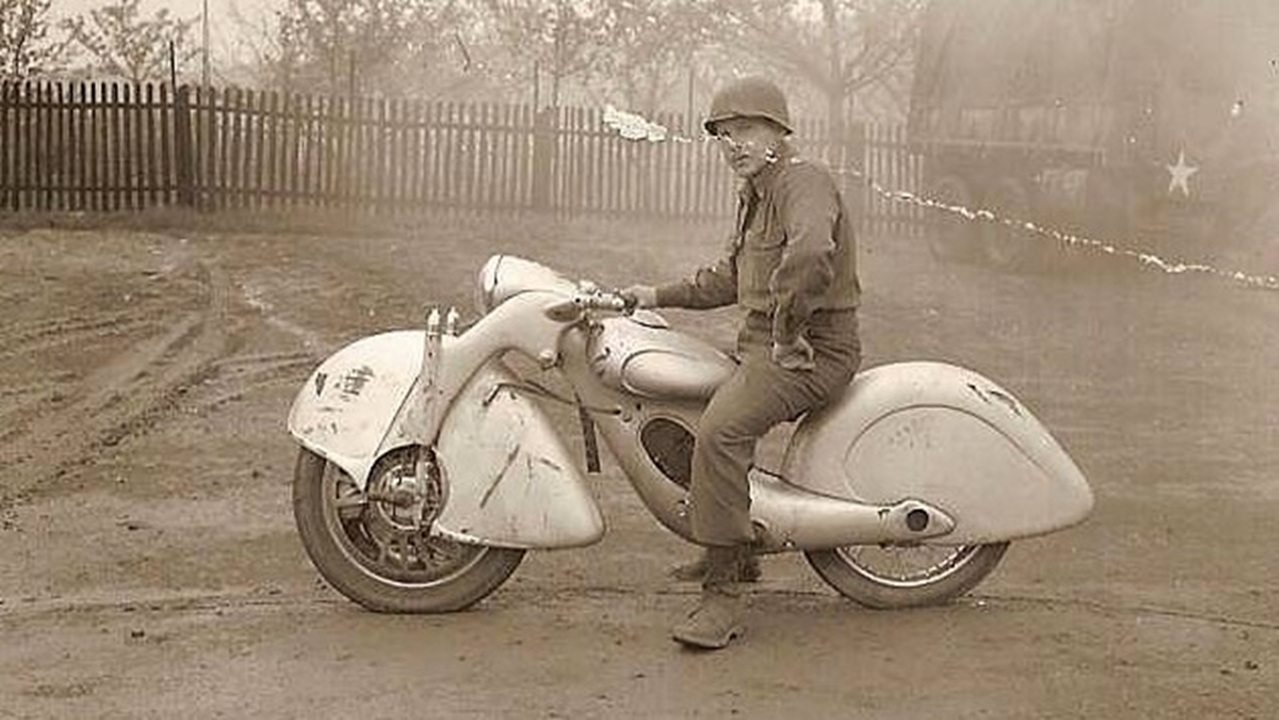
The Killinger und Freund (or Killinger and Freund in English) Peace Dove motorcycle is believed to be a development of perhaps the only well-documented production front-wheel-drive motorcycle, the Megola. Together, these two bikes are among the weirdest motorcycles ever put on the road.
Why Front-Wheel-Drive Can Work
This story starts with the Megola sport motorcycle, and famed motorcycle journalist Alan Cathcart detailed why anyone would even bother trying to make a front-engine, front-wheel-drive motorcycle.
The motorcycles of the 1920s were buzzy affairs with one- or two-cylinder engines shaking their riders as they rode down the primitive roads of the day. Likewise, power losses from the engine to the rear wheel were huge. Cathcart’s story notes that finding and keeping grip on 1920s roads was another issue. In theory, making the front wheel a drive wheel could improve a motorcycle’s traction on a rough road. Cathcart uses the example of the prowess of front-wheel-drive rally cars to show why someone might think that a FWD motorcycle could work.
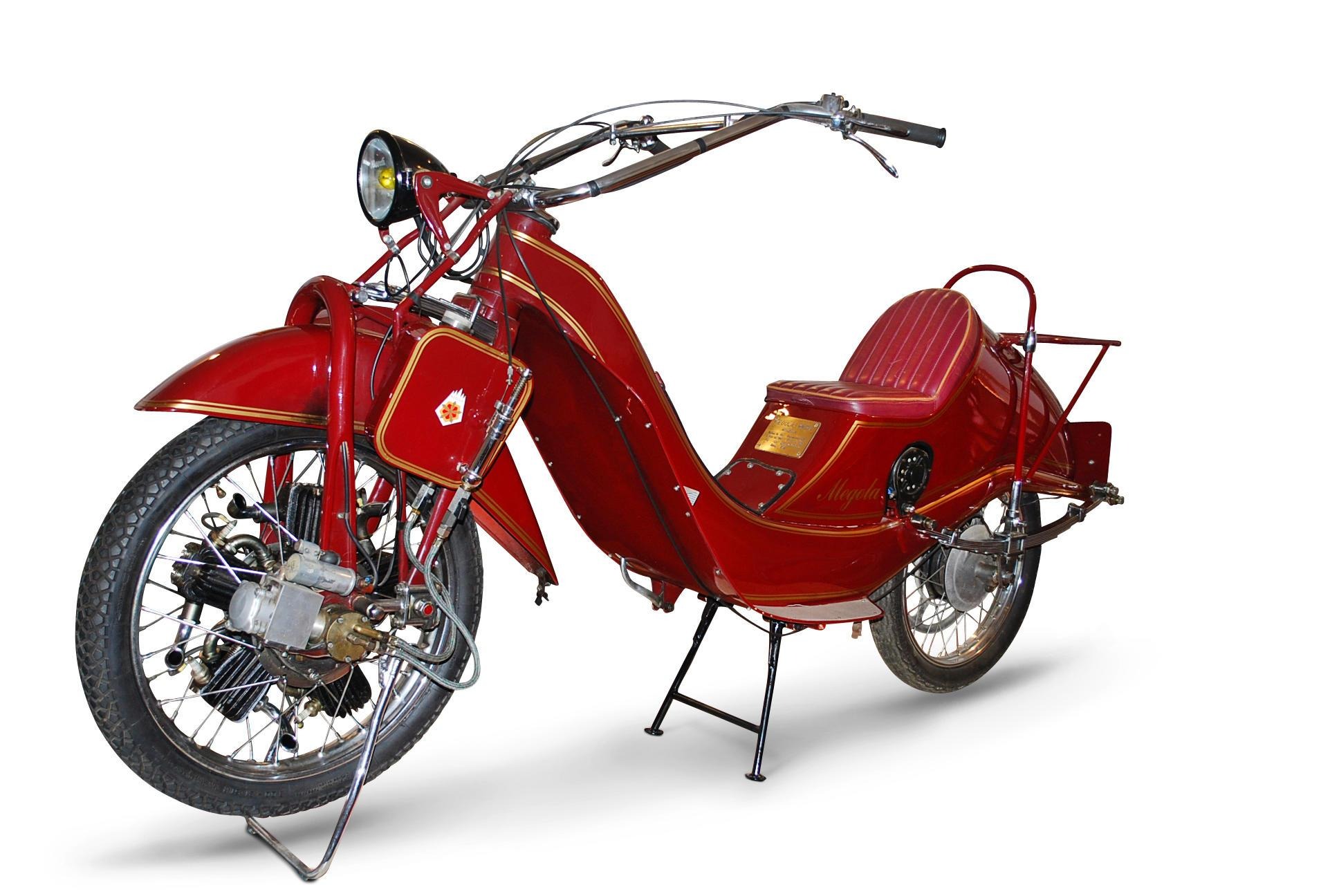
German engineer Friedrich Gockerell (who called himself Fritz Cockerell) certainly saw value in giving it a try. In 1918, Gockerell constructed a motorcycle that featured a three-cylinder engine located in its rear wheel. He’d then upgrade that engine to a five-cylinder unit in 1920. Then, Gockerell reached a breakthrough: What if that engine was attached to the front wheel rather than the rear wheel? In addition to better traction, this motorcycle could also have a low center of gravity, and thus perhaps handle better than a typical motorcycle design.
In 1921, Gockerell joined forces with engineers Hans Meixner and Otto Landgraf to create Megola. As you can probably figure out from the names of these men, “Megola” was just the first two letters of the last names of the founders. Megola’s innovation would be Gockerell’s FWD motorcycle.
As I noted above, Gockerell did not invent the front-drive motorcycle. Cathcart notes that British company Radco had built a prototype FWD bike in 1919, but that didn’t go into production. However, the motorcycling press considered the Megola to be the first “successful” FWD motorcycle in history.
The Megola
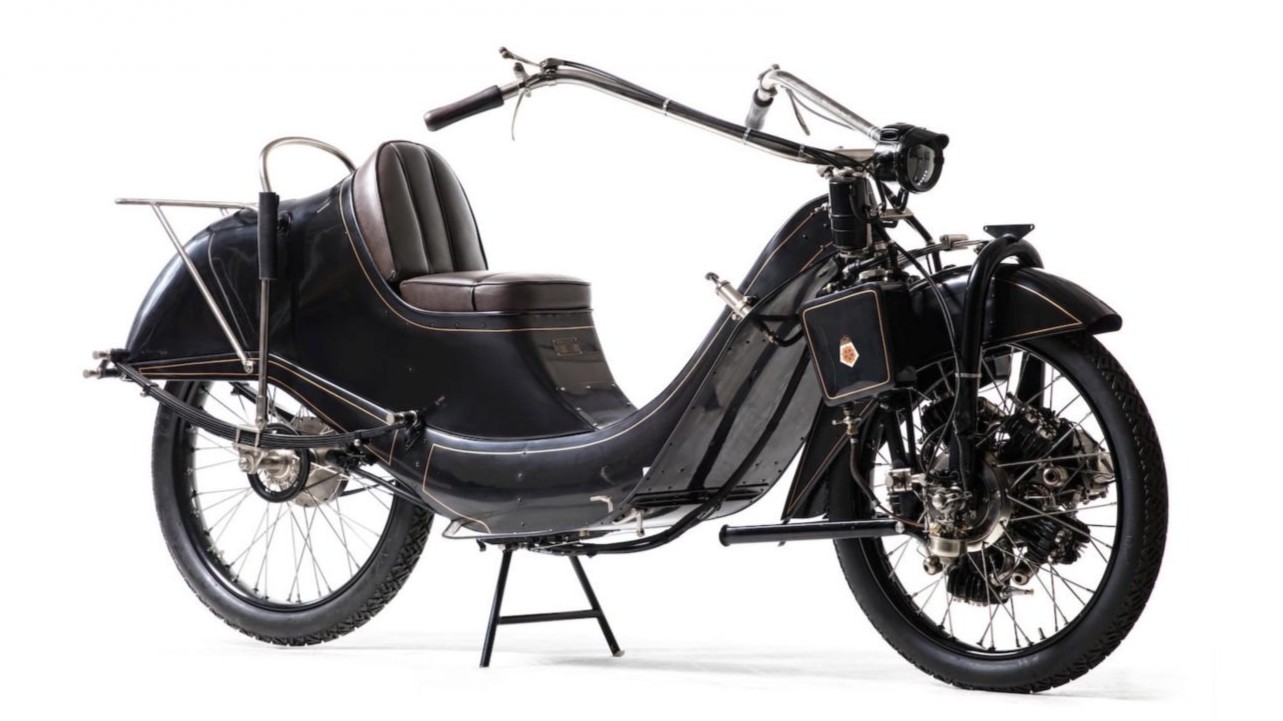
The headlining feature of the Megola motorcycle was its five-cylinder, wheel-mounted engine. Many modern websites will call this a radial engine, and while I can see why these writers came to this conclusion, it is incorrect. The engine in the Megola is actually a rotary engine, but not the kind of rotary engine that you’re thinking about. I’ll explain.
A radial engine design features a fixed crankcase, a revolving crankshaft, and cylinders that are arranged in a radial pattern. Radial engines were once the workhorses of aviation and have also rarely ended up in motorcycles.
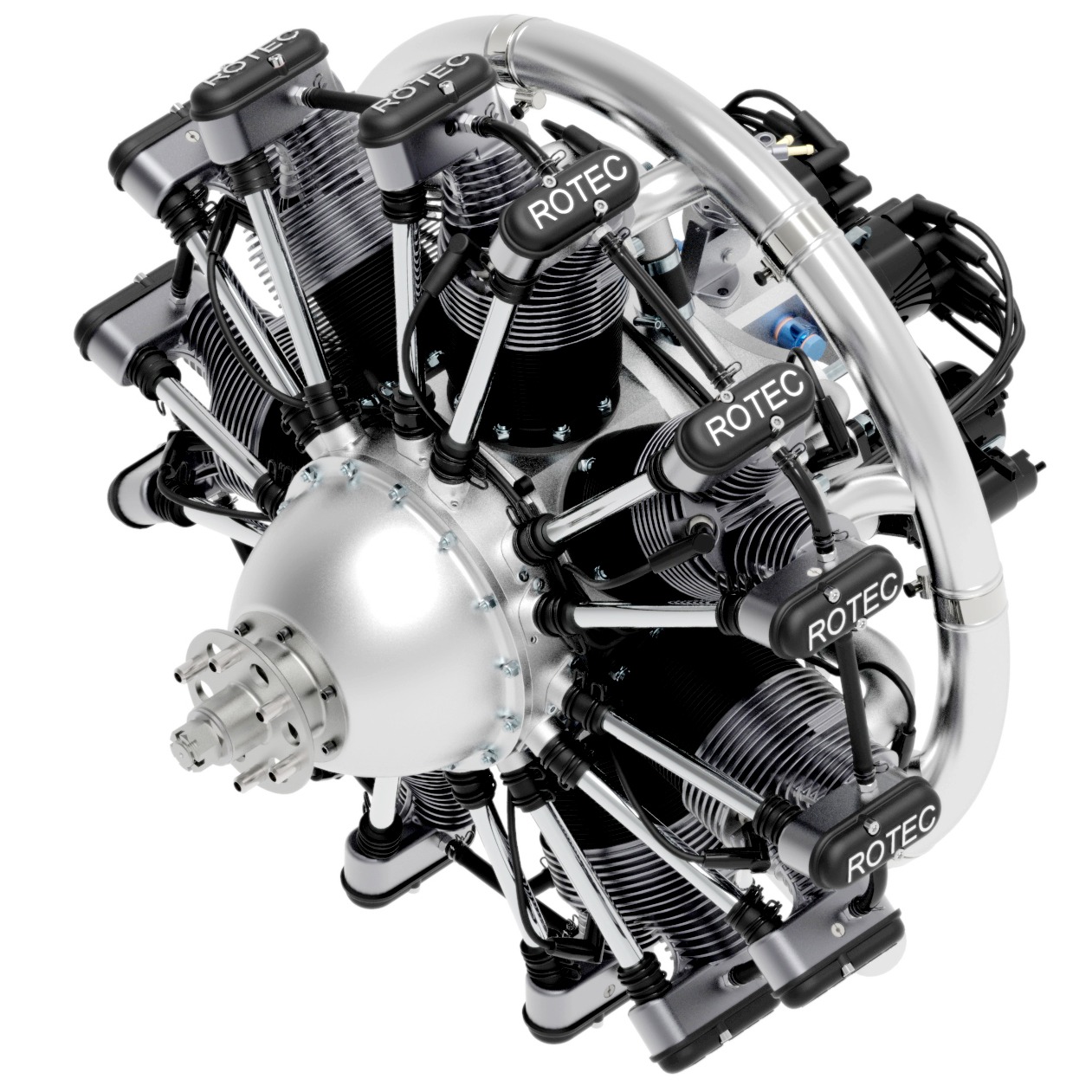
The typical rotary engine, at least as we think of it today, is a Wankel engine, which trades pistons for a spinning Dorito of power.

Then there’s the other kind of rotary engine. These rotary engines will have their cylinders arranged in a circular pattern like a radial engine, but a crucial difference is that in this rotary engine, the crankshaft remains stationary while the entire crankcase, cylinders and all, is what rotates.
Rotary engines were also used in airplanes, and instead of mounting the propeller to the crank as you would in a radial, planes with rotary engines had their props attached to the crankcase. Rotaries are extremely weird, but they did have benefits. Rotary engines transmitted little vibrations to vehicle occupants since the entire crankcase essentially functioned like a giant flywheel. Rotary engines also cooled themselves to a degree since their design saw the cylinders spinning through the air.
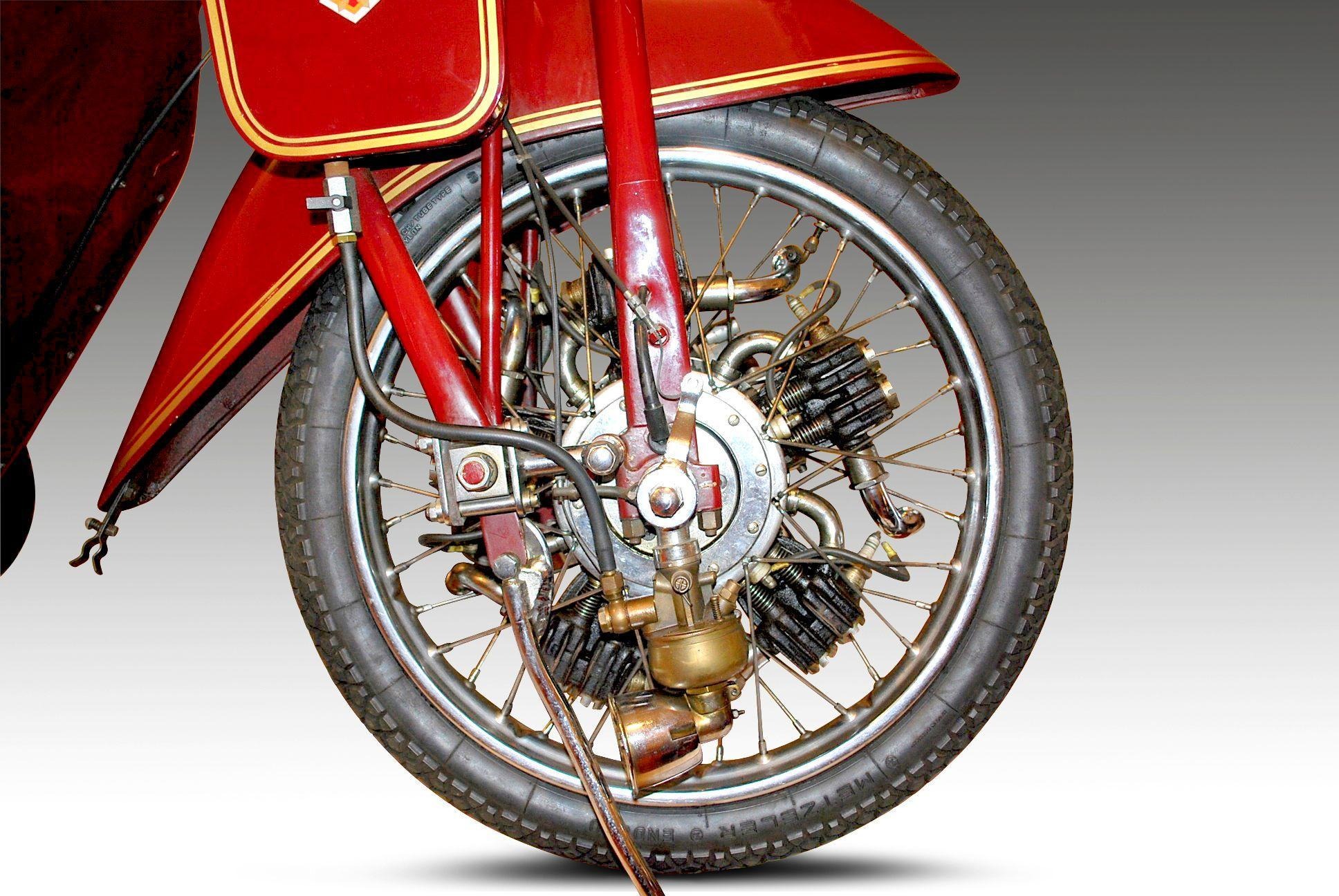
Unfortunately, rotary engines also had inherent issues. For one, the centrifugal force of a spinning crankcase meant that circulating oil through the engine was difficult. Thus, rotary engines required total-loss lubrication like two-stroke engines. Rotary engines in aircraft had a knack for increasing drag — the whole front end is spinning, after all — and as the engines became larger and more powerful, aircraft with these engines became harder to control.
The downsides of having a spinning engine would have their own unique impact on the Megola.
The Megola went into production in 1921 as a Touring model and a racing Sport model. The latter machine had a hardtail (no rear suspension) and a more powerful engine, while the former had a softer seat and a rear suspension. A Megola was pretty luxurious for its day, featuring a full complement of instrumentation including an ammeter, fuel gauge, and tach.
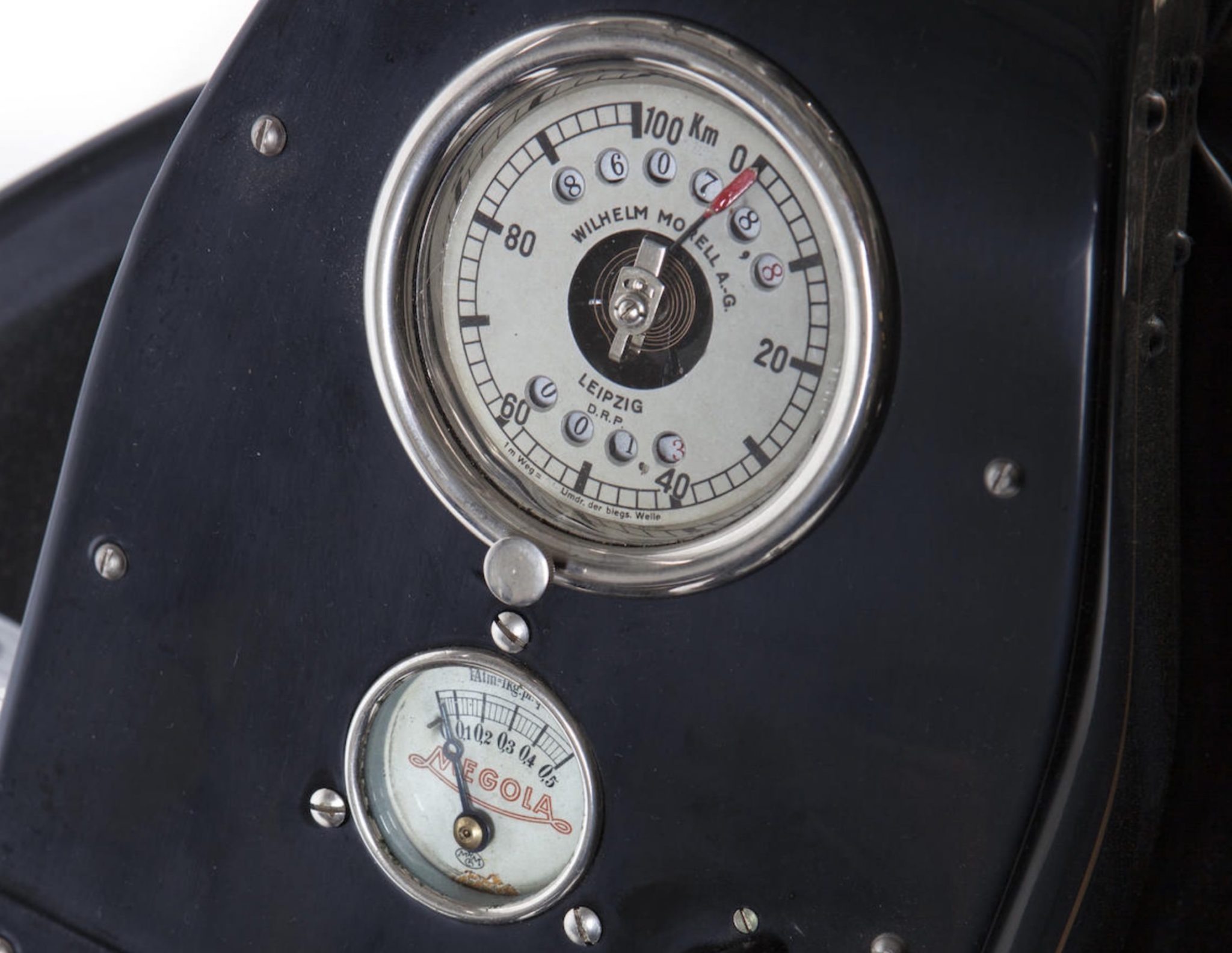
The Chaos Of Starting A Megola
We have to talk about that engine some more. The Megola’s four-stroke five-cylinder rotary had a displacement of 637cc and produced a maximum of 25 HP. The Touring model, which had a weaker 14 HP tune, scooted to a top speed of about 53 mph, and the Sport racer was reportedly clocked at 88 mph. This engine was direct drive without a transmission or a clutch. If the engine was running, the wheel was spinning. Power delivery was controlled through a hand-actuated butterfly valve in the hollow crankshaft.
The lack of a transmission or clutch made the operation of the Megola properly silly. Starting the engine required the rider to either put the motorcycle on its front stand and spin the suspended front wheel, or hop on and push start it. But you absolutely had to be ready to roll because once the engine started, you were off and accelerating.
This made stopping rather hilarious. Megolas had something resembling brakes (a rear brake on the racer and two on the tourer), so stopping was possible. The main issue was that, as Alan Cathcart wrote, you had two decisions to make if you needed to come to a complete stop. The easiest method, as described by the owner’s manual, is that instead of stopping, you’d just ride around in circles until you can progress again.
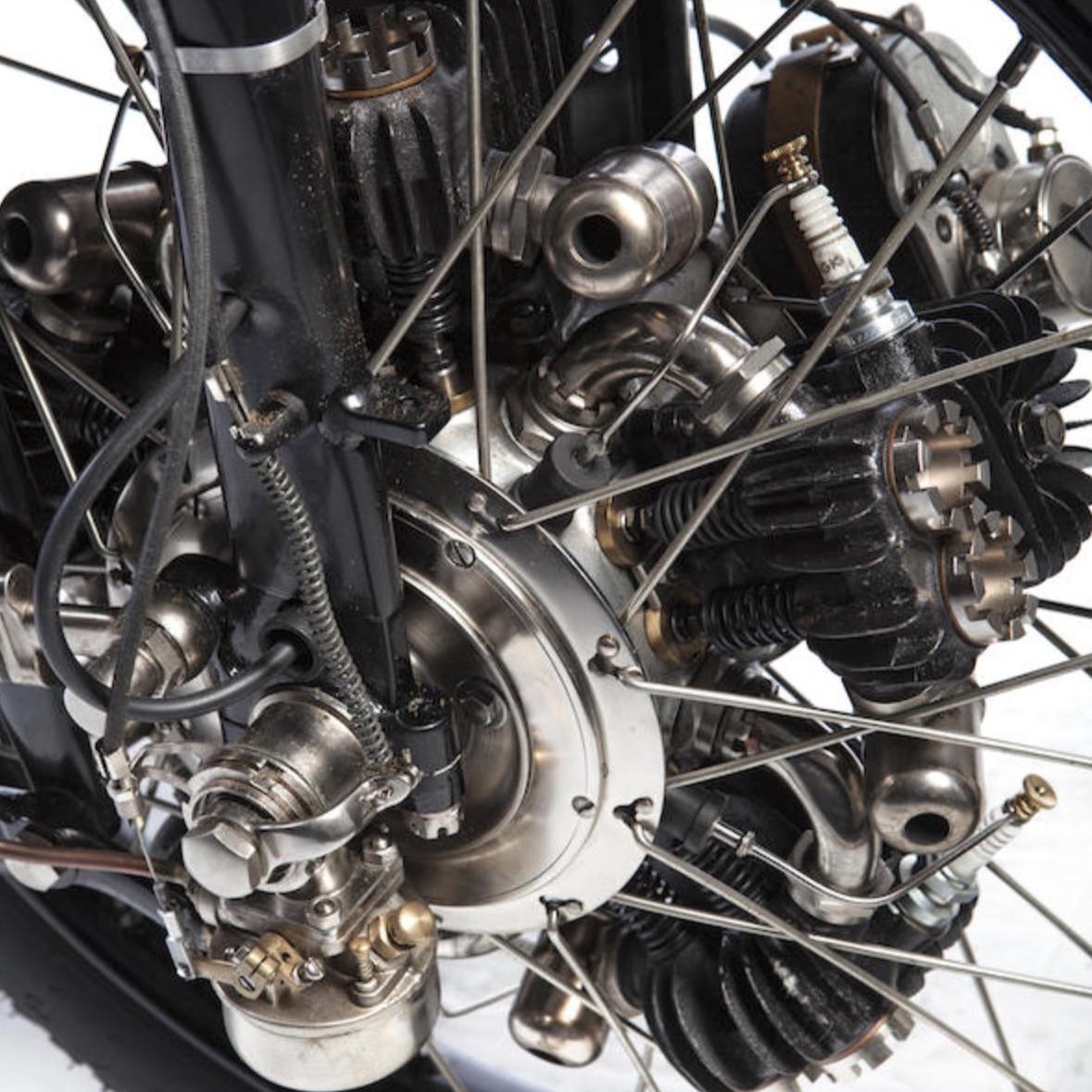
The other method was to come to a complete stop and intentionally stall the engine. Of course, once it was time to get moving again, you’d either need to push-start the bike or put it on its stand and spin the wheel. Oh, and by push-start, I mean you basically run down the road with the bike in your hands, pop the engine decompression lever, and hopefully hop on before the bike takes off without you. Cathcart notes that you were unlucky enough to have left the throttle lever in a high position before push-starting, the bike was happy enough to toss you off and go on a solo adventure. The centrifugal force of that engine-wheel meant that it would take off, right itself, and then ride away perfectly straight until it hit something.
All of that was plenty weird, but the rest of the motorcycle cranked the strangeness up to 11. Megola motorcycles had two fuel tanks. One was located on the front axle. The other was located on the motorcycle’s boxed steel frame. When the fuel tank above the engine ran low, the rider used a hand pump to transfer fuel from the frame tank to the engine tank.
Despite the weirdness, the motorcycle was designed for easy maintenance. The cylinders could be serviced without removing the engine from the front wheel. Likewise, the tires had tubes that were not full circles, so that you could swap out tire tubes without removing the wheels.
FWD Proves Its Worth
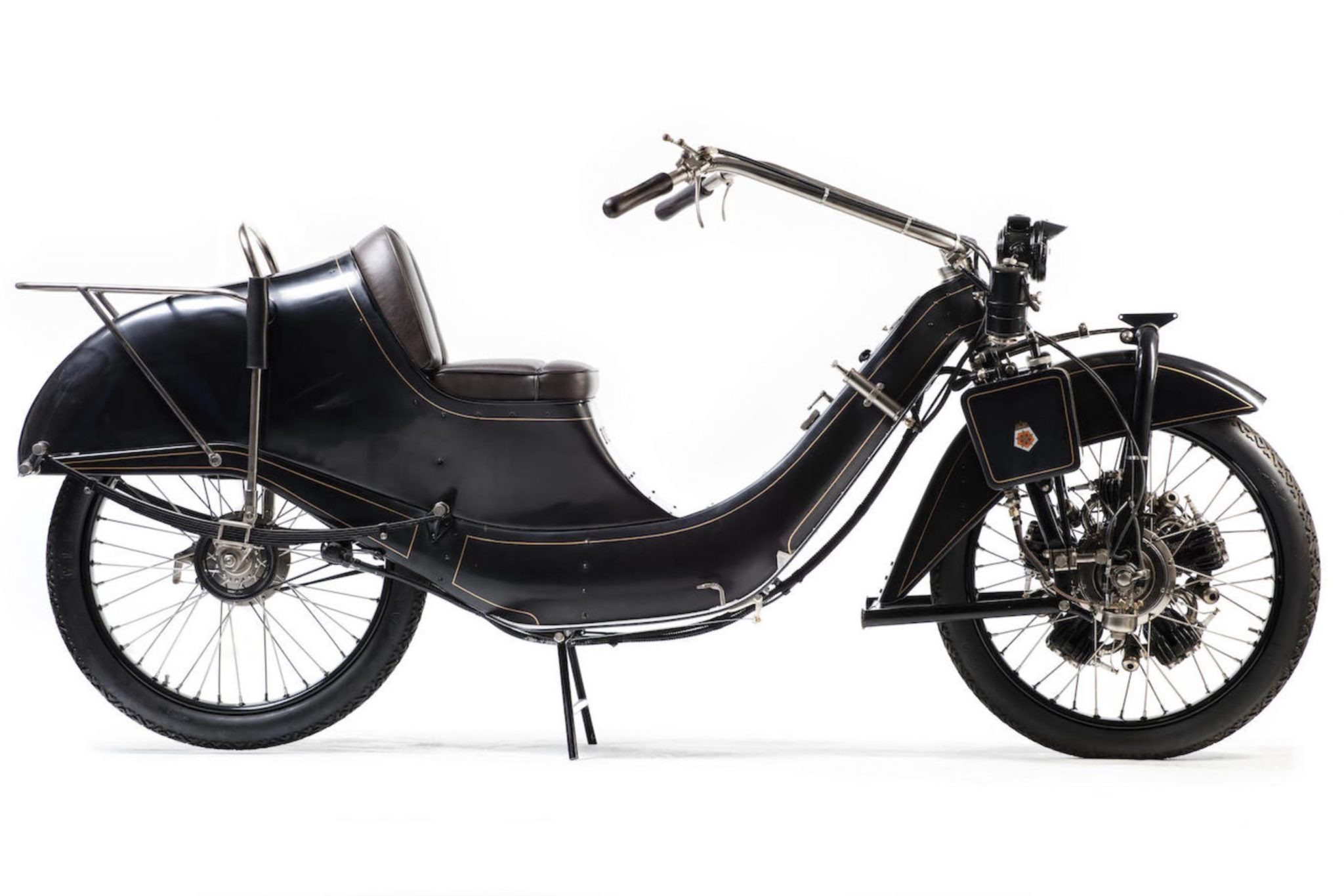
The concept of the Megola was validated on racing circuits around Germany. Megola factory racer Toni Bauhofer took a Megola Sport to 88 mph in 1924. Later, he’d beat BMW to win the Schleizer-Dreieck tarmac race. However, as Cathcart wrote in Cycle News, the Megola was best in dirt:
However, it was in oval track racing in loose sand that the Megola really excelled, the qualities of FWD becoming more readily apparent in conditions where traction was at a premium — as the current research into 2WD motocross development by Sunshine in Britain confirms. Being able to hang the rear wheel out while keeping the throttle cranked wide open, safe in the knowledge that the front wheel is pulling you along in the direction you’re pointing it makes the whole convoluted process of concocting such a device worthwhile. Well, almost.
Check this video out:
As for riding the thing, well, here’s what Cathcart says in a different article for Motorcyclist magazine:
After at least one more fall and even more stalls, I finally mastered the art of achieving forward motion. Riding a Megola on the street—even in the relatively traffic-free days of the early ’20s—must have been pure madness. Not only is there no clutch, but the single rear brake is useless. It’s a complicated dual-action drum—with one internally expanding shoe and another externally contracting one—controlled jointly by a hand lever and foot pedal in what may be the world’s first linked brake system. Squeezing and stamping both for all you’re worth does practically nothing to counter forward progress, however. How anyone managed anything resembling traffic aboard a Megola is a mystery! It’s no surprise that the owner’s manual included special instructions for navigating then-newfangled traffic lights (called “robots” at the time!), advising the Megola rider to “orbit” until the light changed and he could depart the scene. Talk about your Monty Python moments…
I must confess I only rode the Megola in a straight line: a combination of cowardice and mistrust of those towering, 28-inch tires made my progress around turns somewhat, um, restrained. Besides, once the throttle is wound on, it’s practically impossible to go anywhere but straight forward, as you heave manfully on the bars to combat the torque effect. Until you’ve wrestled with a Megola, you don’t know the meaning of understeer!
At the end of the ride, I could only ask why? Why build such a strange machine, requiring so many complicated solutions to problems that never existed until Cockerell created them? Especially since the end result barely functions as a motorcycle? The only plausible explanation is that Cockerell—like so many other creative inventors operating at a time before any firm rules for “proper” motorcycle design were defined—occasionally led himself down a blind alley.
The Megola enterprise failed in 1926 after producing over 2,000 motorcycles, many of which were ruined by the lives of motorsport. Perhaps unsurprisingly, Megola’s failure wasn’t because nobody wanted to ride a motorcycle that couldn’t stop, but because German economy plummeted in the aftermath of World War I, and fewer people were able to afford a luxury toy like this. Gockerell would follow the Megola up with a normal 175cc two-stroke motorcycle.
The Peace Dove
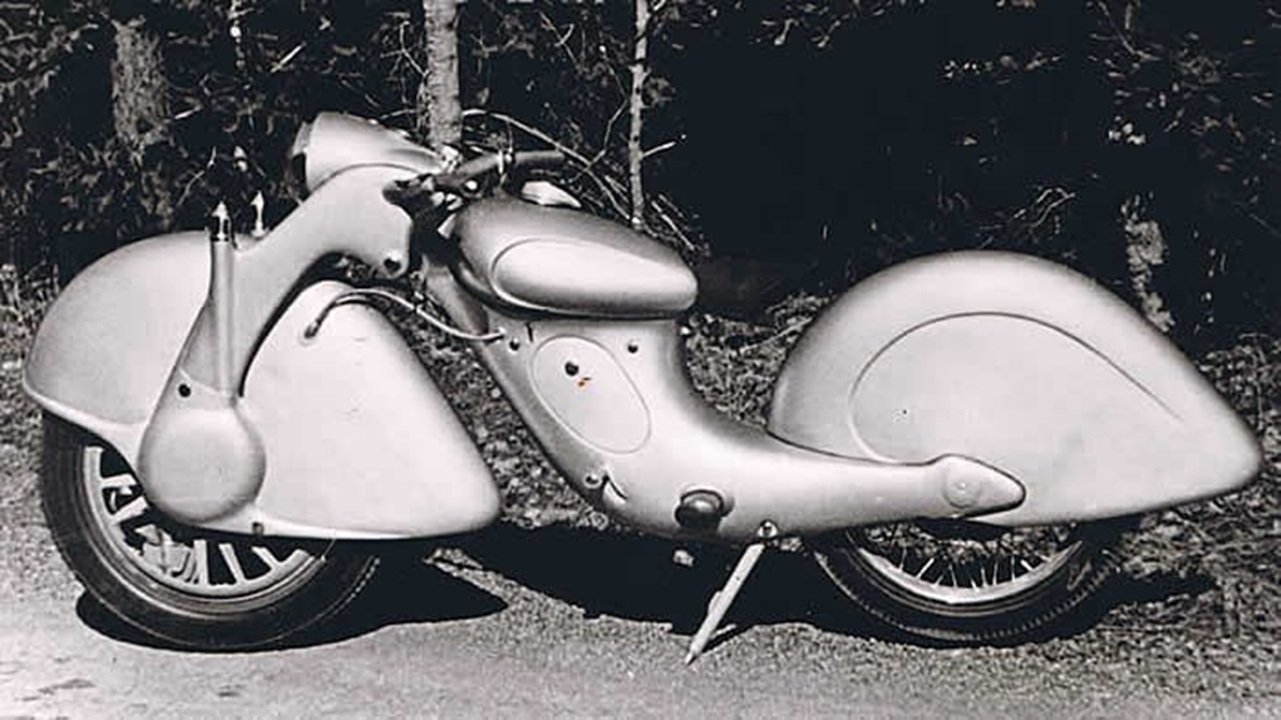
Amazingly, the Megola story does not end there. According to a 1938 issue of German motorcycle magazine Motorrad, five engineers from Munich, including Robert Killinger and Walter Freund, decided to improve upon the Megola design with the Killinger und Freund Motorrad ‘Peace Dove.’ Here’s the text as translated from a German blog:
What the five technicians from Munich – the names of the designers/engineers are KILLINGER and FREUND – now completed is more than an improved MEGOLA. The engine displacement is again 600cc and it is also incredibly light: 135 Kilogr. (with fuel), but this bike has a three-cylinder two-stroke engine in the front wheel, it HAS a transmission and a clutch, it has a comfortable front and rear suspension and looks elegant and thrilling.
There’s always a crowd of people around the displayed bike indicating that there’s happening something great. If you join them and listen to them you will be astonished that most of them like the shape of this bike. That’s important because the technicians wanted to build a bike that can be sold in large numbers some day. The people are used to aorodynamic shapes of car bodies now and it seems that they already expected something like that. The shape was developed to meet all these requirements: all moving parts covered, dirt protection, multicylinder and front-wheel-drive. Another target was to reduce the numbers of different parts. This bike has less parts than a light 100cc-bike!
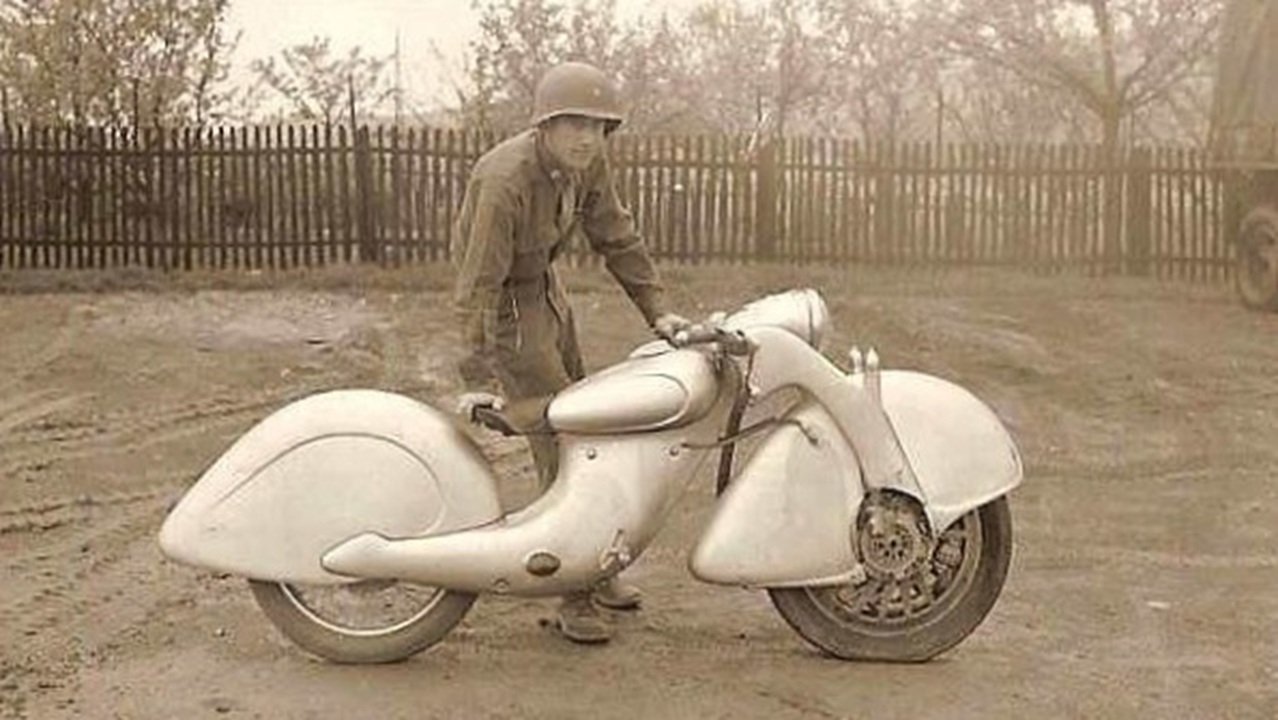
At first sight you realize the dirt-protective and aerodynamic covers of the front and rear wheel. Frame, fork and fuel tank are also aerodynamically improved. We were impressed by the nice details and good shaped transitions of the different body parts, as seen on race bikes. And now the construction: the middle of the frame and the rear wheel cover are currently built as sheetmetal shells around a tube frame. For the mass-production version there are plans to build the middle frame as a boxed frame, welded together, using two pressed sheetmetal parts. Of course this supermachine has a rear suspension. It is linked to the lower end of the (inner) tube frame and fixed with flexible (rubber/metal???) elements which don’t need any service. A lid in the box frame allows access to the seat springs to regulate the hardness of the seat’s suspension.
Better Than The Megola
These engineers used 1930s technology to try to make a more practical motorcycle than the Megola. The Killinger und Freund bike featured a nearly vertical fork. This meant that the wheelbase didn’t change much during stopping and deceleration, like you’d get in a motorcycle with a typical fork rake.
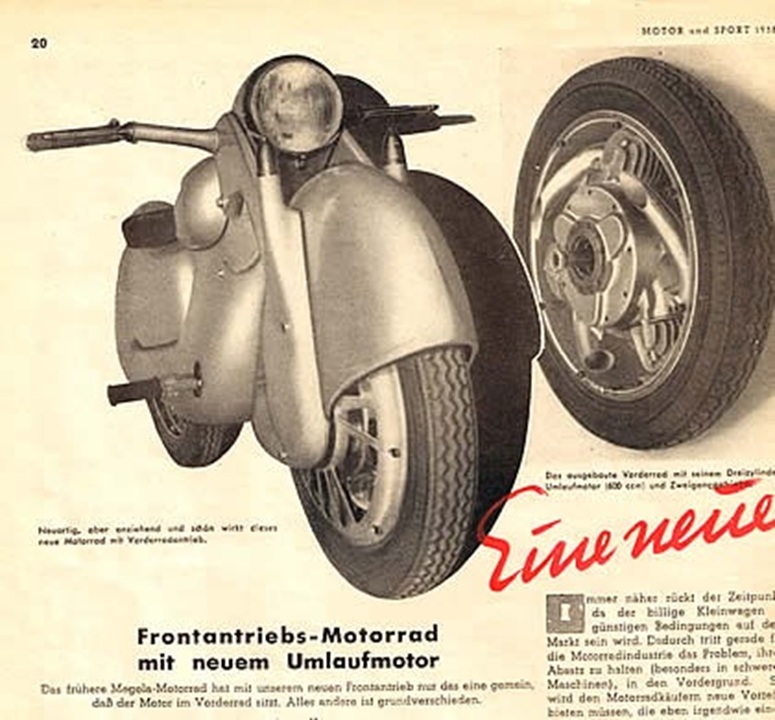
The front engine, which weighed just 110 pounds, reportedly had a ton of design improvements. Most importantly, the addition of a clutch and a two-speed transmission meant that you could actually stop and start the thing in an expected manner. Likewise, Killinger und Freund’s designers also intended the bikes to have a dynastarter (combined starter and alternator) so the whole push-start debacles would be a thing of the past.
The two-stroke three-cylinder (technically three complete single-cylinder engines connected together) engine in the Peace Dove also had an intake rotary disc to better control intake timing for more power. I explained how two-stroke engines and rotary discs work more in-depth, and you can read about that by clicking here. It was also reported that this engine had improved cooling thanks to the front wheel’s spokes being shaped like fan blades.
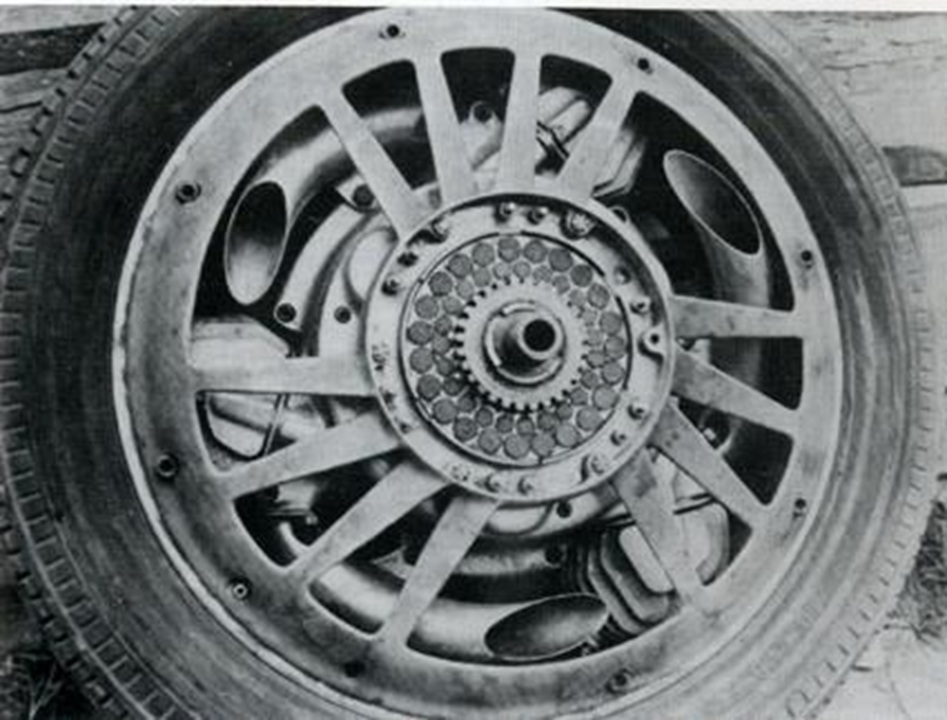
Other improvements in the Peace Dove motorcycle include a more conventional fuel system, stronger brakes, and oil-filled shocks. Reportedly, Killinger und Freund also kept the easy serviceability of the Megola despite the improvements. All of this was wrapped up by striking aerodynamic bodywork.
Motorrad reports that the Killinger und Freund team had spent three years developing the motorcycle and had intended to sell it to the public. Unfortunately, it’s not known just how many of these were built. One of the only reasons that we know the Peace Dove ever existed was because one was found and captured by the U.S. military at the end of World War II. One example was found in a basement in Philadelphia in the 1960s. Its owner was allegedly the daughter of one of the machine’s designers, and the bike had made its way to America at some point.
Lost History
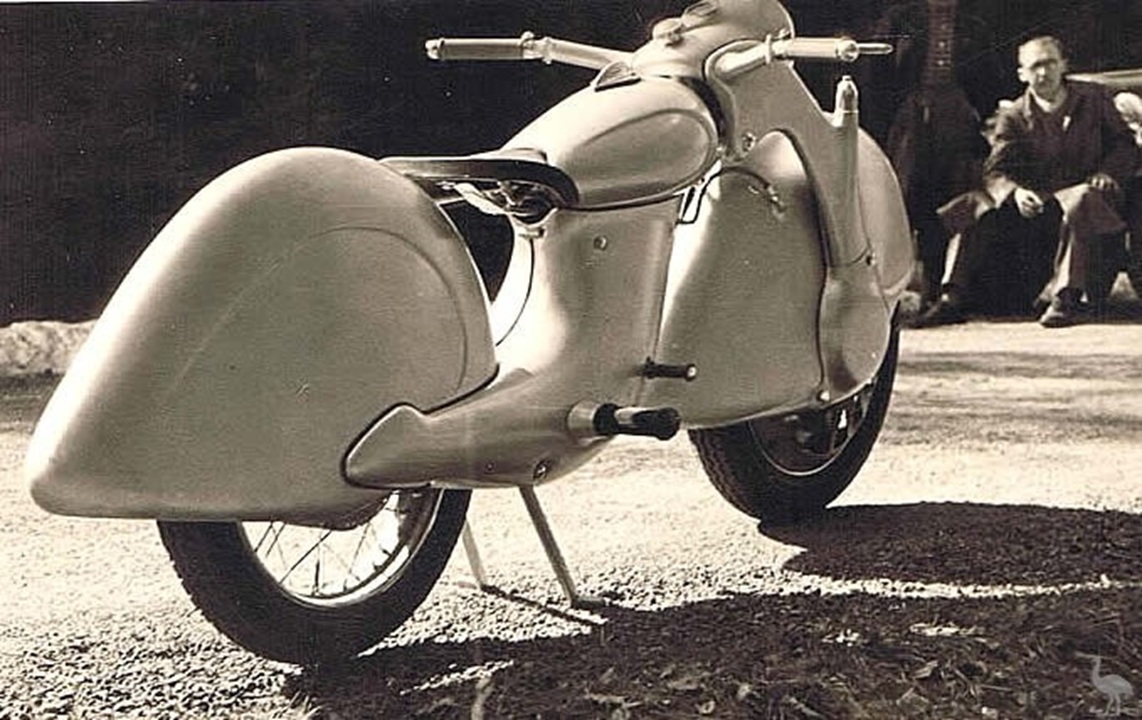
The trail in the Killinger und Freund story goes cold from there. The only pictures of this motorcycle online are tiny and grainy, and there isn’t much information about what happened to the enterprise during the war.
Sadly, it does seem like front-wheel-drive motorcycles were a technological dead end. Sure, FWD had proven itself to be great on dirt tracks, but tradeoffs piled up in pretty much any other situation. As Cathcart correctly noted in his reporting, having a heavy engine whirling away in your front wheel means that the bike will want to continue going straight, making changing direction harder than it needs to be. A FWD rotary motorcycle is also more complex and harder to work on. Nowadays, if a builder wants the benefits of having a driven front wheel, they build a typical motorcycle and connect the front wheel to the drivetrain using a chain drive, ultimately making an AWD motorcycle.
But, at least for a short period in the 1920s and 1930s, at least a handful of engineers thought the future of the motorcycle was in bolting an engine to a bike’s front wheel. In thinking so, they created some of the weirdest motorcycles in history.

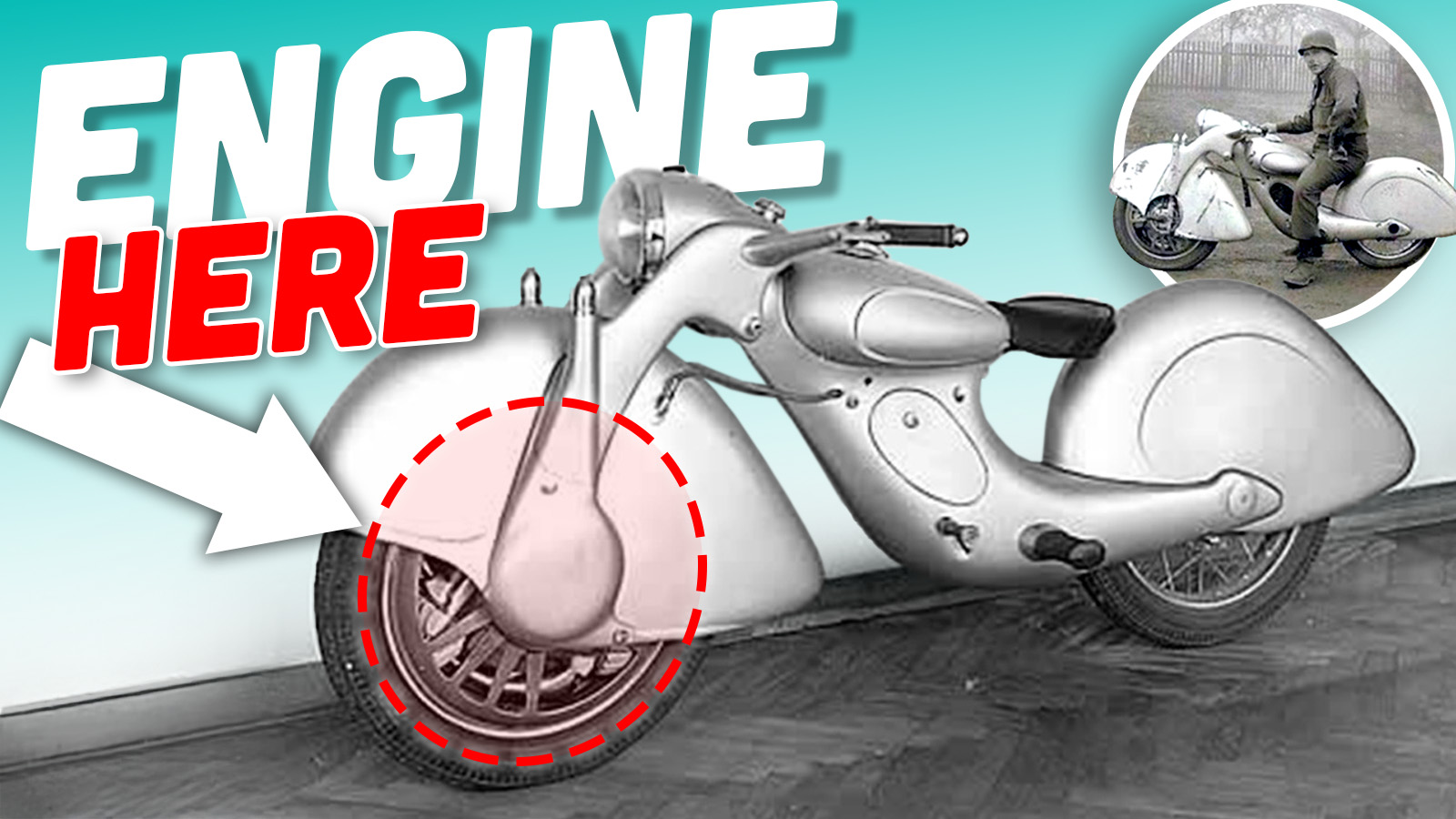






So far the only successful FWD motorcycle, for sufficiently small values of motorcycle, was the Velosolex moped. This stuck a small engine above the front wheel with friction drive. Despite the extra weight above the wheel they were manageable because they had a clutch of sorts, and the same horsepower as weed whacker.
In the last few years we have a lot of e-bikes with front hub motors
Man, I don’t ride but if I did and had FU kinda money I’d make one of these but with electric engines front and back lol what amazing lines this thing has!
The irony is that the pictures Wankel rotary is a DKM, which was Wankel’s original design that used a rotating inner housing. The benefit was that it was completely balanced and could rev to over 25,000 RPM. The drawbacks started with the fact that the engine had to be disassembled to replace the spark plugs, and continued on to being impractical to cool. Production Wankels are the KKM design that eliminated the rotating housing, and are the rotaries that NSU, Mazda, and others actually used.
https://en.m.wikipedia.org/wiki/Wankel_engine
Huh, I thought it looked a bit weird, interesting information, thanks 🙂
You’re welcome! In pure performance terms the DKM was superior, but it simply wasn’t a design that was practical for most uses.
My dad flew a rotary airplane in the mid 40’s it had been rebuilt from some parts, he said it was scary due to the fact it wanted to dive to the left all the time, in WWI the lubrication was castor oil which blew all over the pilot which caused well ‘issues’
On a tangent, but there’s been a few more recent examples of 2WD bikes, including the Yamaha WR450F 2-Trac that won the 2004 Paris-Dakar 450cc class (including three outright stage wins).
https://www.bikesales.com.au/editorial/details/7-two-wheel-drive-motorcycles-105527/
But how about 2WD AND 2 wheel steering ?
https://motocrossactionmag.com/bikes-youve-never-seen-before-1990-drysdale-dryvtech-250/
That thing looks straight outta cyberpunk! Thanks for sharing I’m definitely saving that for the memory banks!
One of the French motorcycle and moped manufacturers, Motorbécane, built VéloSoleX, the front-wheel-drive moped from 1946 to 1988.
Motobecane also known for their bicycles.
What has not been mentioned in the article and hardly can be seen in the video: The Megola‘s engine does not rotate with the wheel, but in the opposite direction – and five times as fast, if I remember correctly. Truly an ingenious thing.
Oh wow I assumed it was direct drive!
Not enough rpm for a smoothly running engine I suppose. But yes, makes the thing even crazier 🙂
Great article, especially with all the info about the Megola!! More than two decades ago I first learned about the Megola and got pretty fascinated by it even though motorcycles aren’t usually my cup of tea; over the years I’d sporadically (ha, yeah, I knew that word before Clueless ever came out) look it up online but I’d only find scant information; needless to say, I never found any for sale, lol, though I did once come across a listing for a Megola front fork. It’d been a while, though, since I last did an internet search. I would occasionally post comments about the Megola on this very website and other sites such as the German lighting site in the hopes that people would reply with information but to no avail. So this article is a real goldmine of info about Megola (& Killinger und Freund!), thank you for that & kudos to you!!
One does wonder what kind of oil the Megola used; I know many WWI-era planes used castor oil. On the Car Talk radio show and website many years ago the Magliozzis once talked about how tough those WWI pilots were because they had to endure the effects of breathing in castor-oil-laden exhaust (which is actually why they wore those long silk scarves; they’d wrap those around their mouths & noses in an effort to filter out the castor oil and periodically move the scarves to a fresh section) and since castor oil has laxative properties the pilots would make a beeline for the nearest outhouse as soon as they landed. One hopes that riding a Megola wouldn’t have the same effect, lol.
Amazing article! The scariest thing to me was the rear steering bike. I rode over 50 years and would never attempt to ride a rear steering bike. I just can’t imagine.
Ohlins and Yamaha got together and made 2WD WR450s, and at least one 2WD R1.
It seemed to have a little less unsprung weight, though, powering the front wheel with a hydraulic drive system.
Funnily enough, a friend ended up with one of these in his collection. A couple of them made it to the importer in Bulgaria as display/ad pieces, one returned to Greece or something like that, the other one he bought after it sat in the showroom for ten-ish years.
Before that it was given for an extended test to one of the local Enduro clubs in a PR op, they got to the top of a mountain peak with it and were quite impressed.
Mostly by how much it felt like a normal bike, with just the minimum front wheel drive kicking in every single time it was needed.
The streamlining treatment does make for some cool looking bikes, but I imagine the gyroscopic forces were significant and I wouldn’t want to ride one.
The Megola in the video has the opposite of “ape hanger” bars I see on some Harleys around here. “Knuckle draggers?”
Writing an entire article about front-wheel drive motorcycles and NOT mentioning the beautiful creation from Craig Rodsmith feels almost sinful. His bike might be the most beautiful thing I’ve ever seen.
https://www.bikeexif.com/front-wheel-drive-motorcycle-art
Thanks for bringing this development branch up with such good detail.
The evil thing that was never really dealt with was the unsprung weight.
But wait, it is time for another go round, but this time the future looks electric. (-;
Many is the time I’ve been out on my motorcycle, negotiating Houston traffic with no protective cage surrounding me, and have thought to myself “ya know what would make this even better? if I had absolutely no way to actually slow down or stop this thing, I could just ride around in circles instead of stopping!”
If anyone could build a gas powered FWD motorcycle it would be Rokon, they got a disconnect for the front wheel that actuates when the front wheel is turned too far in either direction.
That being said the only application I can see for it would be a trike with undriven rear wheels.
“Peace Dove” is an interesting choice for something built in 1938 Germany. Was it also a total loss oiling system? That must have been rough sitting at lights and having that exhaust come out essentially right below your head. Tough to choose between dealing with that or having to ride around in circles.
Of course since I watched the imbeded video, this came up on my YouTube suggestions:
https://www.youtube.com/watch?v=4TeqwcJjQgY
Jay Leno with a 1922 Megola Touring at Pebble Beach
(The video doesn’t properly make the rotary/radial distinction.)
Rotary engines are quite weird on planes. Using them on a motorcycle is insane. On planes, they basically don’t have a throttle. The ‘throttle’ is just a blip switch that turns the engine off/on.
If any of you are ever in the southeastern NY / northern NYC area on a summer weekend, check out Old Rhinebeck Aerodrome. They do airshows every weekend where they fly WWI and earlier planes, some of which have rotary engines.
https://oldrhinebeck.org/
I used to live a few miles away – just south of Barrytown, great bunch of people., and an amazing collection. They have some outstanding cars and motorcycles many of which they run on a regular basis. Can’t recommend them enough.
From the dawn of the Industrial Revolution to the Great Depression, we (as a society) didn’t know what we didn’t know, and there was plenty of money to explore any idea that showed even the vaguest of promise.
Absolutely. These ideas only look foolish in hindsight once we know they don’t work. As an idea, this doesn’t seem any crazier than swapping out a dependable, solid rubber tire for one filled with compressed air (prone constant air loss and of course punctures).